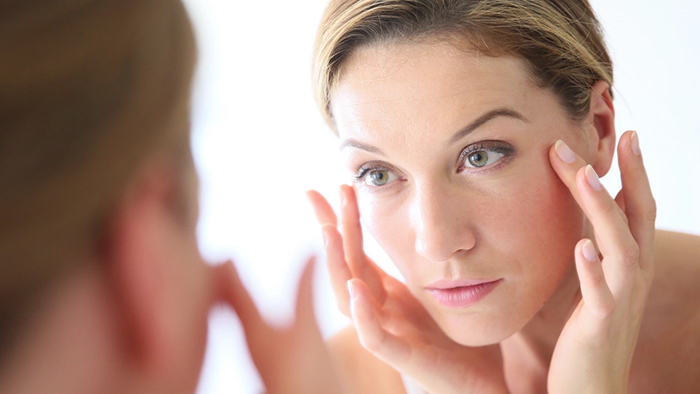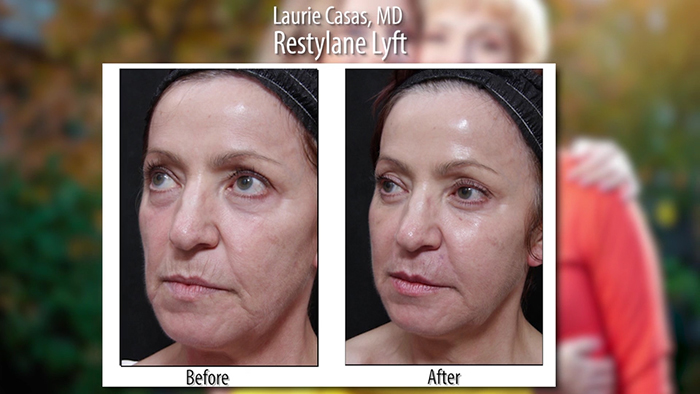At the recent annual meeting of the American Society of Aesthetic Plastic Surgeons, Dr. Laurie Casas was invited to speak to her colleagues about “Mom Genes.” This new tool developed by medical dermatology giant, Galderma intends to demonstrate and predict an individual’s aging process by studying mothers and daughters. Dr. Casas points out, “…moms and daughters age similarly. We know how we are going to look when we see our parents, yet fighting the aging process is dependent upon the individual.” The problem is most of us don’t understand exactly how we are aging. Identifying and treating the causes and effects – both genetic and environmental – can go a long way toward slowing down the clock. Recognizing what is involved in making sure our 50 is the new 30…well, that will take some self-discovery (and a little help from mom.)
by Isabel Bolt
and Laurie Casas, MD
A Different Type of “Snapchat”
Dr. Casas often asks patients to bring in pictures of themselves from each decade since their teen aged years. Since all features are pushed up when you smile, she prefers non-smiling pictures. “We collect the photos and put them in a chronological presentation. It’s a powerful way to communicate. The patient can immediately see how they have morphed over the years.” In our 20’s we all have higher cheekbones, wider jawlines, and more oval shaped faces. In our 50’s there is mid-face volume-loss – more skin laxity and a triangular shape to the face.
According to Casas, simultaneously assessing a patient’s mom, whether in pictures or in person, takes mom genes to another level where personal aging and genetic factors are considered side by side. But Casas emphasizes an important part aside from focusing on mom, that that’s how an individual is aging. “A lot of women want certain features corrected like thinning lips, drooping brows or deepening nasolabial folds,” she explains. “This exercise gets them to understand the science behind their own aging. It demonstrates loss of volume, loss of elasticity, and sagging skin.” The next question is obvious: ”What concerns does that patient want to treat, and how do we want to accomplish those objectives?”
When and How to Start the Fight against Aging
It’s never too early or too late to take steps to look your best. The importance of looking youthful has no age limit. In fact, many in their 60’s, 70’s, even 80’s are leading busy lives and have high expectations that they will continue to look as good as they feel.
There are dozens of forks in the road to the fountain of youth. The route is very much up to the individual. Some people are comfortable with less intervention; others want more. Casas sees patients at all junctions in their journey. “Some patients are content with skin care and sun protection. Others see a wrinkle and want to treat it immediately. In any case, I am there to help them. Whether minimally invasive or surgical, we come up with a game plan that satisfies their objectives.”
Nature or Nurture?
Are genetics or lifestyle to blame for aging? It turns out it’s “clearly genetics,” says Dr. Casas, “but influenced by lifestyle.” Smoking, drinking, excessive sun exposure, and stress all speed up the biological clock. However of all these factors, sun damage reigns enemy #1. In fact, UVR is the greatest threat. Without sun damage some say we would probably not develop wrinkles until we were in our 80’s!
Dr. Casas on the Basics
Regardless of the type or extent of intervention, Casas always starts with the skin. “Skin quality is critical. Without tone and texture you won’t look good no matter what you do. Nothing is more beautiful than an aging person with beautiful skin.” Hydration is key since we lose the ability to hydrate as we age. As skin ages, its qualities change. Collagen and elastic fibers are degraded and the quality of the body’s own hyaluronic acid is reduced. This results in decreased skin elasticity along with roughness and dryness of the skin.
With all the products on the market, Casas encourages her patients to stay connected with a trusted physician or registered nurse for lotions and potions that really work. “I believe in customizing your regimen based on your needs. My practice offers something for almost every type of skincare need and issue.” She teaches patients about the essential components of good skincare: Cleansing, exfoliating, hydrating and protecting. Making changes as a patient’s skin responds (or stops responding) is part of staying on top of developing individualized protocols. “There are outstanding products based on science on the market today. I only offer products I believe are effective and that I have personally tested.”
















Facebook
Twitter
Instagram
YouTube
RSS